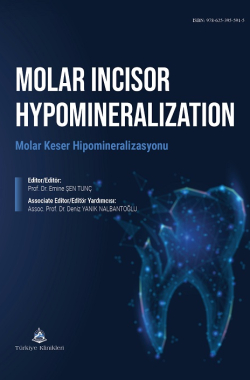Time and Circumstances for Extraction of Molar Incisor Hypomineralization-Affected Teeth?
Gökçe Elif ERDAYANDIa , Ramazan KÖYMENa
aAntalya Bilim University Faculty of Dentistry, Department of Oral and Maxillofacial Surgery, Antalya, Türkiye
Erdayandı GE, Köymen R. Time and circumstances for extraction of molar incisor hypomineralization-affected teeth?. In: Şen Tunç E, ed. Molar Incisor Hypomineralization. 1st ed. Ankara: Türkiye Klinikleri; 2025. p.79-81.
ABSTRACT
Molar incisor hypomineralization (MIH) is a developmental disorder typically affecting the permanent first molars, characterized by a reduction in the inorganic components of the enamel. The management of MIH is challenging due to variability in clinical presentation and treatment needs. Early diagnosis can facilitate more effective treatment and lower costs. Tooth extraction in MIH-affected teeth is indicated in cases of excessive crown destruction, pulp involvement with material loss, or infection due to abscess formation. Timing of extraction is critical to prevent complications such as lateral movement of adjacent teeth or overeruption of the opposing teeth. Extraction timing should be determined based on clinical and radiographic evaluations. Additionally, compensation and balance extractions are employed to maintain occlusal harmony. These methods are applied depending on the level of malocclusion and the current status of the teeth. The ideal timing for extraction in MIH treatment should be planned according to the child’s age, the degree of tooth mineralization, and individual needs.
Keywords: Dental enamel hypoplasia; time-to-treatment; tooth extraction
Kaynak Göster
Referanslar
- Almuallem Z, Busuttil-Naudi A. Molar incisor hypomineralisation (MIH) - an overview. Br Dent J. 2018;225:601-9. [Crossref] [PubMed]
- Weerheijm KL. Molar incisor hypomineralization (MIH): clinical presentation, aetiology and management. Dent Update. 2004;31(1):9-12. [Crossref] [PubMed]
- Weerheijm KL, Duggal M, Mejàre I, Papagiannoulis L, Koch G, Martens LC, et al. Judgement criteria for molar incisor hypomineralisation (MIH) in epidemiologic studies: a summary of the European meeting on MIH held in Athens, 2003. Eur J Paediatr Dent. 2003;4(3):110-3.
- Lygidakis NA. Treatment modalities in children with teeth affected by molar-incisor enamel hypomineralisation (MIH): A systematic review. Eur Arch Paediatr Dent. 2010;11(2):65-74. [Crossref] [PubMed]
- William V, Messer LB, Burrow MF. Molar incisor hypomineralization: review and recommendations for clinical management. Pediatr Dent. 2006;28(3):224-32.
- Ghanim A, Silva MJ, Elfrink MEC, Lygidakis NA, Marino RJ, Weerheijm KL, et al. Molar incisor hypomineralisation (MIH) training manual for clinical field surveys and practice. Eur Arch Paediatr Dent. 2017;18(4):225-42. [Crossref] [PubMed]
- De Aguiar Grossi J, Cabral RN, Leal SC. Caries experience in children with and without molar-incisor hypomineralisation: a case-control study. Caries research. 2017;51(4):419-24. [Crossref] [PubMed]
- Mahoney EK. The treatment of localised hypoplastic and hypomineralised defects in first permanent molars. N Z Dent J. 2001;97(429):101-5.
- Jälevik B, Möller M. Evaluation of spontaneous space closure and development of permanent dentition after extraction of hypomineralized permanent first molars. Int J Paediatr Dent. 2007;17(5):328-35. [Crossref] [PubMed]
- Williams JK, Gowans AJ. Hypomineralised first permanent molars and the orthodontist. Eur J Paediatr Dent 2003;4(3):129-32.
- Thilander B, Skagius S. Orthodontic sequelae of extraction of permanent first molars. A longitudinal study. Rep Congr Eur Orthod Soc. 1970:429-42.
- Thunold K. Early loss of the first molars 25 years after. Rep Congr Eur Orthod Soc. 1970:349-65.
- Cobourne MT, Williams A, Harrison M. National clinical guidelines for the extraction of first permanent molars in children. Br Dent J. 2014;217(11):643-8. [Crossref] [PubMed]
- Demirjian A, Goldstein H, Tanner JM. A new system of dental age assessment. Hum Biol. 1973;45(2):211-27.
- Ong DC, Bleakley JE. Compromised first permanent molars: an orthodontic perspective. Aust Dent J. 2010;55(1):2-14; quiz 105. [Crossref] [PubMed]
- Teo TK, Ashley PF, Derrick D. Lower first permanent molars: developing better predictors of spontaneous space closure. Eur J Orthod. 2016;38(1):90-5. [Crossref] [PubMed]
- Patel S, Ashley P, Noar J. Radiographic prognostic factors determining spontaneous space closure after loss of the permanent first molar. Am J Orthod Dentofacial Orthop. 2017;151(4):718-26. [Crossref] [PubMed]
- Canpolat M, Daimi birinci büyük azı dişlerinde yapılan kontrollü çekimlerin klinik ve radyografik sonuçları [Doktora tezi]. Ankara: Ankara Üniversitesi; 2020. [Link]
- Bishara S. Development of the dental occlusion. Textbook of orthodontics. 1st ed. USA: W. B. Saunders Company;. 2001. p:53-60.
- Kiraz M, Yüksel BN, Sarı Ş. Daimi birinci büyük azı dişlerinin kontrollü çekimleri: derleme. Acta Odontologica Turcica. 2018;35(2):56-61. [Crossref]
- Gill DS, Lee RT, Tredwin CJ. Treatment planning for the loss of first permanent molars. Dent Update. 2001;28(6):304-8. [Crossref] [PubMed]

